Last Updated on: February 4, 2025
It’s exciting to wake up to sightings of brightly-colored birds in your backyard.
Luckily…
Many orange and black birds love exploring nectar feeders and birdbaths. Do you know which birds have such plumage?
Below is a list of the most common birds with orange and black plumage in North America to show you distinguishing features to help you identify the ones that visit your backyard.
Common Orange And Black Birds: Discover 16 Species
Bird size, habitat, plumage, and favorite foods are four characteristics that differentiate one species from the other. Let us look at that below.
1. Red-winged Blackbird
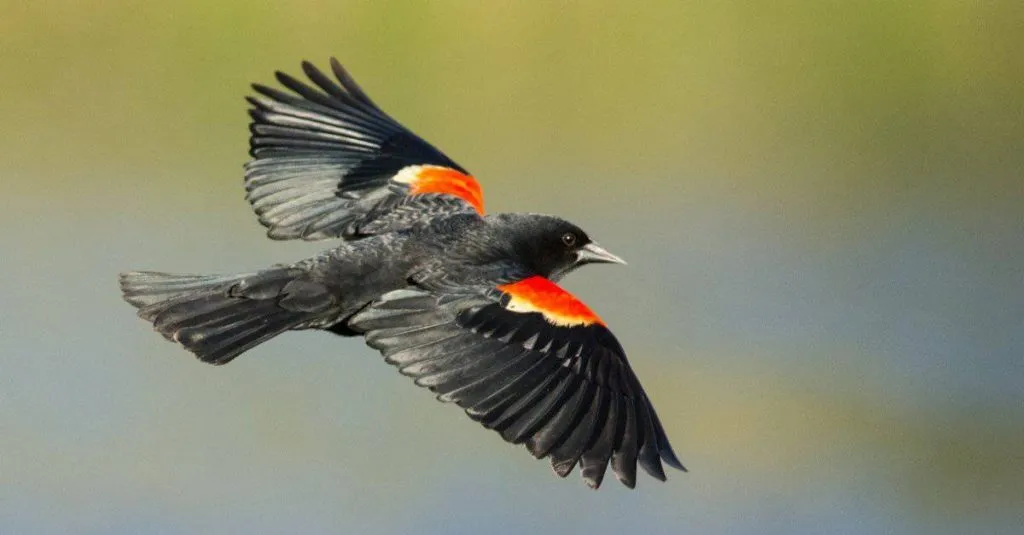
Red-winged blackbirds are the most popular brightly-colored birds because of their black body and orange patch on the shoulder. It looks like an American crow.
But, despite this resemblance, it’s smaller than an American crow because the former is between 6.7 and 9.1 inches long, while the latter has a body length between 15.8 and 20.9 inches.
This species breeds in the northern area of North America and flies south to wintering grounds in California and Mexico.
Other parts of North America and Central America have a resident population; thus, you can see these orange and black birds throughout the year. This species is on this list because of the plumage of male birds.
The female has brown streaks, while the male has a glossy black body and orange shoulder patches.
2. Black-headed Grosbeak
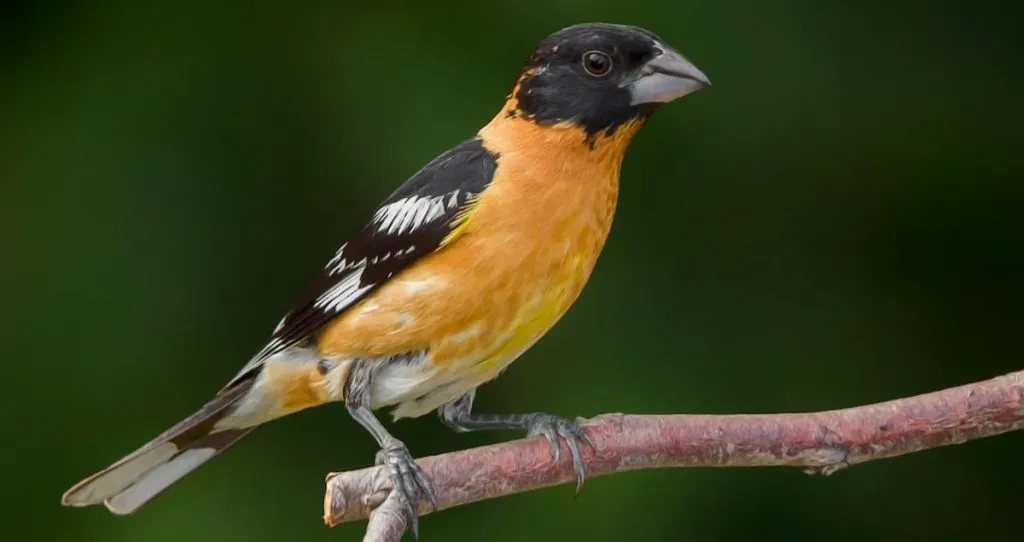
This one will have you staring at it for hours because of its orange and cinnamon belly contrasting its black back and black head. The female is even more colorful because it has an orange breast and streaked flanks.
Another detail to help you identify the black-headed grosbeak is its long bill that extends from its forehead to its throat. Unfortunately, this species is only in the western states of the United States.
The black-headed grosbeak breeds there and flies a short or medium distance to winter south in Mexico. If you want to see it any time of the year, fly to Mexico, as there’s a resident population.
This bird loves insects, so you’ll find it exploring the understory. But if you’re in the western states, install a bird feeder to draw it to your backyard and watch it up close.
3. American Redstart

This tiny bird is between 4.3 and 5.1 inches long, and it has bright orange plumage on its wings, tail, and flanks. It’s so stunning!
Insects make up most of its diet, and it catches them in open woodlands. Hence, your backyard should have vegetation where the American redstart can find insects. If not, plant magnolia thickets, as this species also eats berries.
An American redstart is a long-distance migrant that breeds in the eastern and northern states of North America and winters in Florida, Central America, and South America. Some birds winter in California too.
4. Blackburnian Warbler

Its orange throat distinguishes it from other warblers in North America. This bird also has an orange head, a white belly with black streaks, and black wings.
It’s a small species that averages between 4.3 and 4.7 inches long. You’ll find it in the eastern states with its breeding grounds in the northern area of the continent and the wintering range in South America.
You’ll hear a blackburnian warbler before you see it because it hides in the canopy.
Fortunately, you can attract it to your backyard in the summer months or as it migrates.
5. Varied Thrush

It’s one of the larger birds on this list as it can grow between 7.5 and 10.2 inches long. Its most striking features are its orange belly with a black stripe and blue-gray upper parts. However, a female has brown instead of black plumage.
A varied thrush has a different diet in summer and winter, with insects making up most of its diet in summer while fruits and nuts come in handy in winter.
A varied thrush spends most of its time in low shrubs, hopping on the ground as it catches insects. There are resident birds along the Pacific Coast, while the breeding season sees the varied thrush head north of the continent.
6. Baltimore Oriole

It’s one of the most colorful bird species on this list of black and orange birds. The male has an orange rump, a black head, orange outer tail feathers, and a black back. A female’s head and upper parts are brown or yellow.
The Baltimore oriole breeds in North America and flies to winter in Florida or farther south in Central and South America.
This oriole loves open woodlands and forest edges. It spends most of the time in a forest canopy, but you’ll see it fly low to eat fruits. Luckily, it also visits backyards to sample nectar or orange slices. That’s where you should wait for the Baltimore oriole if you aren’t planning a birding expedition out of town.
7. Western Tanager
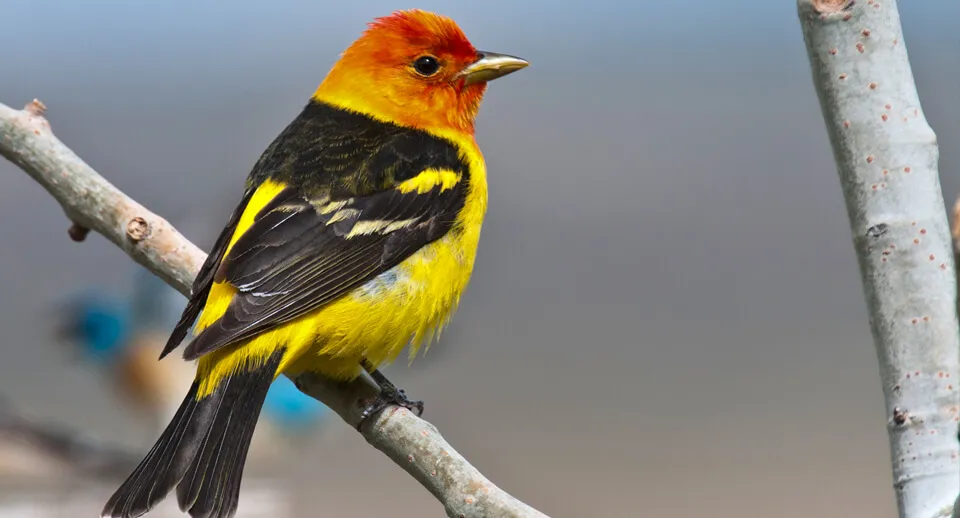
A western tanager has an average size as it can grow up to 7.5 inches long. You know it’s a tanager if it has white wing bars contrasting its black wings, an orange-red head, and a yellow body. A male western tanager gets the orange-red pigment from insects. The female isn’t as colorful with its plumage averagely yellow.
This songbird lives in forests near water, inhabiting the canopies. It breeds in coniferous or mixed woodlands. Therefore, you may see it in the Pacific Northwest in states like California.
8. Bullock’s Oriole
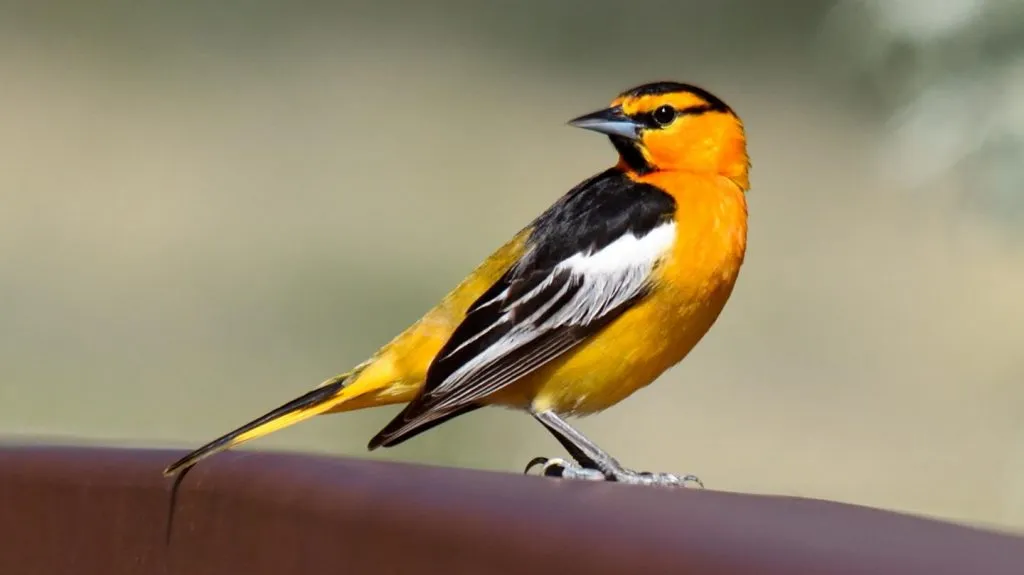
The heads and bellies of males have bright orange plumage, while their black backs have white wing patches. On the other hand, the female orioles have gray and orange plumage. You’ll see the Bullock’s oriole in cottonwoods, willows, or backyards with nectar feeders.
The wintering range is in Mexico, while the breeding range is in the western states like California and Colorado. It’s a small songbird about the size of a red-winged blackbird, and it eats insects when fruits and berries aren’t available.
This avian builds a nest up to 25 feet from the ground. It selects a lone tree or the edge of a wooded area. In most cases, you’ll find its nest near water.
9. Orchard Oriole
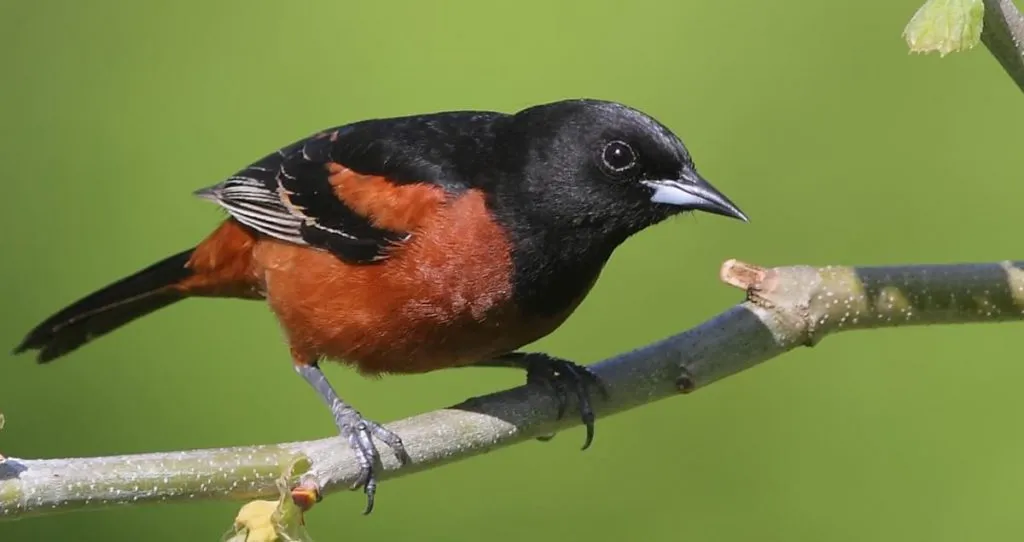
This one is easy to see in suburban and urban areas throughout North America. You might also find it in woodlands and mangrove forests in the eastern states. The Orchard oriole loves tall trees, where it can fly unobstructed.
However, it isn’t that particular when choosing a nesting site as it can nest anywhere with enough space for its tiny nest.
The male has a black head and back, and its underside has chestnut feathers that mimic a burnt orange color. The female has a greenish-yellow body and gray and white wings.
An orchard oriole is between 5.9 and 3.1 inches long, and it loves when you offer orange or mango slices in a nectar feeder. It also eats berries like mulberries and chokeberries.
10. Eastern Towhee
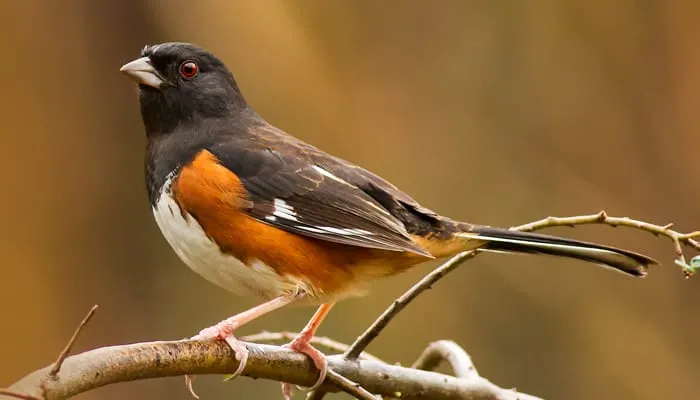
A male has reddish-orange flanks, a black back, and a black head. A female doesn’t have a black head or black. Instead, it has brown plumage.
An eastern towhee is between 6.8 and 8.2 inches long, which means it’s larger than a house sparrow. You’ll see it in the southeastern states of the U.S. though it migrates to wintering grounds in south Texas.
This avian isn’t a species to look for in the canopies as it loves undergrowth in tickets and edges of forests. Therefore, even when it comes to your backyard, you’ll probably see it gathering fallen seeds.
11. American Robin

You must have seen an American Robin at least once, if not every day. It’s a common species in North America that also visits backyards looking for earthworms, sunflower seeds, peanut hearts, and fruits. Its average body length is 7.9 to 11 inches, so we can say it’s a medium-sized bird.
Though it’s a resident species, it’s also a short-distance migrant with a breeding range in Canada and wintering grounds in Mexico and Florida. In the wild, it inhabits woodlands, fields, and parks. A female robin starts building the nest from inside, unlike other species that begin with the outer structure and then furnish it with soft materials.
You’ll know an American robin by its black head and back, plus red or orange underbelly.
12. Spotted Towhee
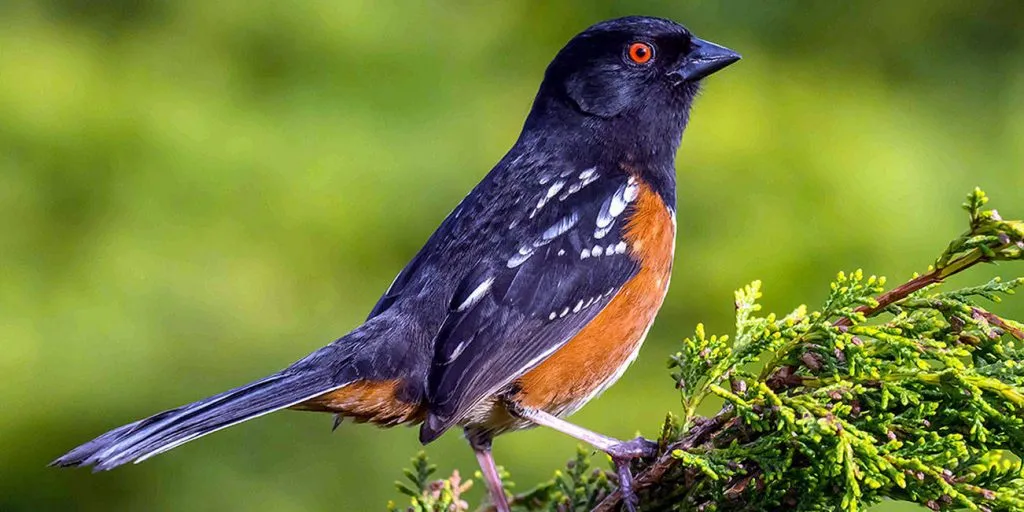
Adult males and females have orange-brown flanks, white wing bars, and a white belly. Nonetheless, males have black upperparts and throats while females flaunt brown backs. You’ll only see this species in your backyard if it’s shrubby.
If it’s not, visit a forest edge or a field with an understory where you’ll find this avian looking for grasshoppers, caterpillars, and beetles. It also eats berries and seeds.
A spotted towhee is between 6.7 and 8.3 long, and it’s a short-distance migrant that flies from the northwestern area to a wintering range in Texas and Mexico.
13. Hooded Oriole

It lives in dry but open areas near palm trees. A hooded oriole can build a nest up to 20 feet from the ground. It breeds in the southern states, where you’ll come across nests that resemble baskets made of grass and plant material hanging on palm fronds.
It takes a female between three and six days to weave grass and plant fiber into a nest that’s four inches tall. When the nest is ready, she lays three to seven eggs and incubates them for 14 days.
You’ll know a male hooded oriole by its bright yellow or orange underside, black throat, and black upper parts. A female oriole doesn’t have black markings on its face. The orioles in Texas have more orange plumage than the ones you see in the West, and this species averages 7.1 to 7.9 inches long.
14. Altamira Oriole
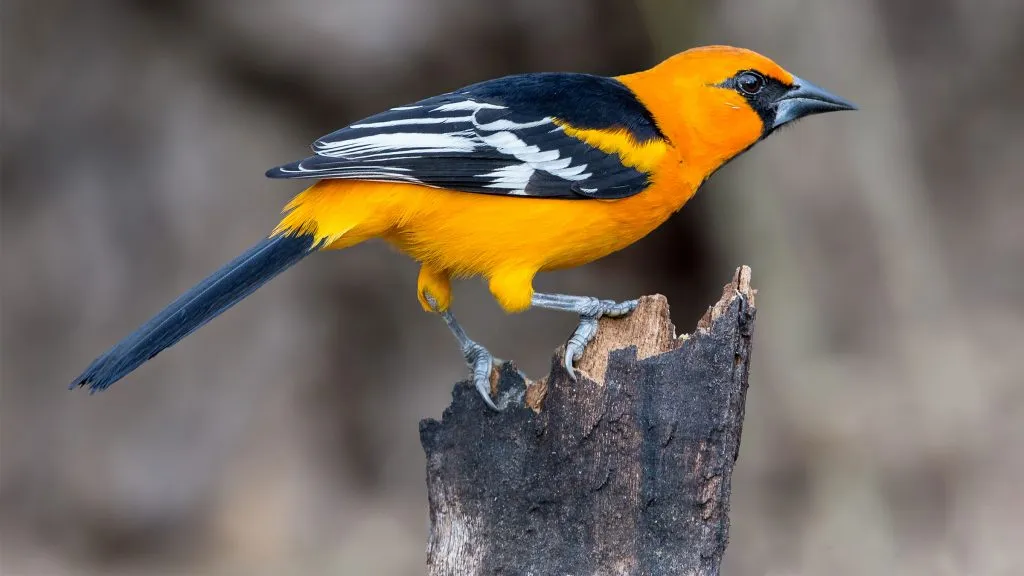
Have you heard about this one before? It’s the largest oriole in the United States. Details to help you differentiate it from other orioles are a pointed bill, a bright orange body, a black mask, and a black upper back. It’s one of the few avians with the same plumage for both sexes, as the female also has a black mask.
The Altamira oriole inhabits dry woodlands and open fields with scattered trees. You might also see it in arid scrublands. It’s not as large as a common grackle as it’s 8.3 to 9.8 inches long.
Unfortunately, this species is only in the southern part of Texas, around Rio Grande Valley, and parts of Mexico and Central America. If you haven’t experienced bird watching in those areas, it’s time to plan a trip there.
15. Scarlet Tanager

It breeds in the eastern side of North America and winters in South America, where it mixes with other foragers, such as flycatchers and woodcreepers.
You’ll also spot a scarlet tanager looking for berries in plants like mulberries, strawberries, and blackberries. You won’t see it often as it perches in the canopy. However, if you want to see it in your yard, attract it with some of the berries mentioned above.
Male and female scarlet tanagers have two different body colors, as a male has a bright red body while a female is olive-green. The wings and tail of a male or black, while those of a female have a dark olive color.
16. Vermilion Flycatcher

This flycatcher isn’t as common as other birds on this list because you only spot it on the southern edge of North America and Mexico. It’s a resident species in Mexico, with a few birds wintering along the coasts of California and Florida.
The vermilion flycatcher is a small bird between 4.8 and 5.4 inches long. The female has a brown back, a reddish belly, and a white breast. On the other hand, a male has red underparts and a black back. When a male is courting, it brings the female a gift of a shiny item.
A breeding pair nests up to 30 feet from the ground. The nest sits on an open branch, and it accommodates two to four eggs until they hatch about 16 days later.
Watch This!
Frequently Asked Questions
What bird has an orange breast in black wings?
Bullock’s oriole fits this description. It’s a species you see in states like Arizona, New Mexico, Oklahoma, and Texas. The most outstanding feature of this avian is its orange underbelly and its black upperpart.
Are orioles rare?
Yes, there’s a population decrease of some species found in North America. For instance, the Altamira oriole found in parts of Texas appears on the list of threatened species. About 500 Altamira orioles are in the U.S.
The most common species is the Baltimore oriole, though it’s also decreasing. Others that you’re likely to see more are Bullock’s oriole, hooded oriole, and orchard’s oriole.
Is a red-winged blackbird rare?
No, it’s one of the most common species as it has a resident population in North America. It breeds in the northern area and migrates to the southwestern edge in winter. However, the resident birds in the southern and western regions rarely migrate.
Conclusion
Our list proves there are many black and orange birds throughout North America. Most of them are small species that love backyard nectar feeders, meaning you’ll see most of them often. The only thing you need to do is learn their migratory routes and where they spend the breeding or wintering seasons.
Using the birding information you gather, prepare your backyard by installing the correct feeders and nest boxes. Additionally, there are resident birds you can see any time of the year, such as the red-winged blackbird.

